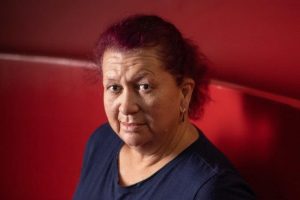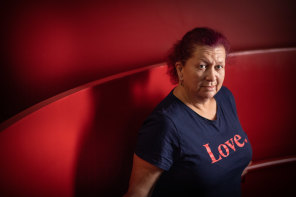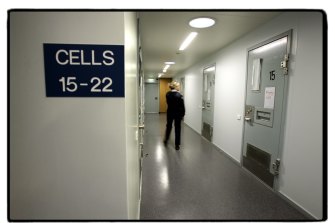Calls for law and order rethink as the number of women in jail soars

A leading justice reform group is calling for a rethink on law and order, saying the actions of violent men have led to legislative changes that are contributing to women being locked up at an alarming rate.
The report from RMIT University’s Centre for Innovative Justice, released on Thursday, says government policies aimed at improving the response for women in the justice system are undermined by wider reforms following significant public episodes of violence.
Dorothy Armstrong said prison didn’t helped her, it only harmed her.Credit:Eddie Jim
Access to parole was restricted because of rapist and murderer Adrian Bayley, bail laws became tougher because of James Gargasoulas’ massacre in Bourke Street and community-based sentences have been limited.
The reforms were intended to help Victorians feel safer by curbing the threat of high-risk offenders but combined, the report says they are having a disproportionate impact on low-level women offenders who are being pushed into higher thresholds for bail, up the sentencing hierarchy and into custody at an alarming rate.
The latest Corrections Victoria figures show a record 44 per cent of the 7274 inmates overall were unsentenced and for the second month in a row in May, there were more women on remand than have been sentenced.
The numbers of prisoners on remand, groups such as the Sentencing Advisory Council have found, are driving exponential growth in prison numbers overall.
The growth is more pronounced among women prisoners, even though they make up a much smaller proportion of the prison population.
The number of women entering the system increased by close to 174 per cent in the decade to 1594 in June 2020, compared with a 109 per cent increase in men.
The number of Aboriginal and Torres Strait Islander women being incarcerated is also growing faster than any other group, with a 321 per cent increase in Aboriginal women entering prison in the same period.
The Dame Phyllis Frost correctional centre.Credit:Angela Wylie
The paper has called for wide-ranging strategies to reduce the female prison population, with a key recommendation being the reversal of the bail laws enacted in 2018. The threshold was changed to make it harder to get bail and also meant people who committed an indictable offence – which could include minor crimes such as shop theft – while on bail or on community corrections orders, were taken back into custody.
Centre for Innovative Justice associate director Elena Campbell said focusing on women was a chance to implement change and measure its impacts, so lessons could be applied more broadly.
“Criminal justice reform often occurs in response to the violent offending of men,” she said.
“The community rightly expects to feel safe from this type of offending, but would not expect that the impacts of reform would be carried disproportionately by women, especially when women generally commit low-level offences and are often victims of male violence themselves.”
Such was the case for Dorothy Armstrong, who was first a victim of family violence and abuse as a child, before she came into contact with the criminal justice system.
“Prison didn’t help me. Prison further damaged me,” she said.
Ms Armstrong, now a peer support worker with the Centre for Innovative Justice, said her actions landed her in prison, but contributing to her path there were her experiences of being victimised by men.
Once out of prison, at her parole appointments there were notice boards advertising for groups and housing opportunities for men, while she scrambled to the phone box each day to ring services to find somewhere to sleep for the night.
“My needs were safety from men, accommodation of my own, counselling and help to become part of whatever community,” she said.
Former chief magistrate and state coroner Ian Gray said the reforms to bail were a response to grave and serious offending. Community safety was critical, but the higher prison numbers and in particular the high remand numbers were a problem.
“The numbers are telling a story. They’re dramatic, and they’re unsustainable and the cost, of course, is immense,” he said.
Former chief magistrate and state coroner Ian Gray says the new bail laws create the risk of injustice, particularly for low-level offenders.Credit:Eddie Jim
Mr Gray said the tests for bail are logical, but were capturing far too many lower-level offenders.
“Far too many are imprisoned on remand, many of whom will not attract prison sentences when they are sentenced,” he said.
“The new bail laws create the risk of injustice, particularly for low-level, repeat offenders. There needs to be a renewed emphasis on tackling the underlying causes of criminal offending and a clear recognition that many offenders are affected by such things as mental health disorders, unemployment, lack of education and homelessness.”
Corrections Minister Natalie Hutchins said the government was always looking to improve how the justice system operates.
“This includes funding for increased support for women in custody to maintain and strengthen family ties – helping to reduce reoffending and keeping women out of prison when they return to the community,” Ms Hutchsin said.
“We have a strong focus on tackling the root causes of offending through early intervention – to prevent crime, reduce reoffending and provide genuine opportunities for Victorians to turn their lives around.”
Ms Armstrong said stable housing was fundamental to her life changing.
“Having somewhere safe and affordable and stable to live was pivotal. I needed somewhere safe to start de-compressing from my life, I needed somewhere safe to just start breathing.”
Start your day informed
Our Morning Edition newsletter is a curated guide to the most important and interesting stories, analysis and insights. Sign up here.
Most Viewed in National
From our partners
Source: Read Full Article



